هل شعرت يومًا أن مؤسستك عبارة عن فوضى من العمليات المتشابكة التي يبدو أن لها حياة خاصة بها؟ أنت لست وحدك. قد يكون من المحبط أن تشعر بأنك تسير على غير هدى. أو ما هو أسوأ من ذلك، تجربة أنظمة وعمليات جديدة لا يبدو أنها تحرك الإبرة.
في بعض الأحيان، تكون أبسط طريقة لإحداث تغيير في عملك هي أبسط طريقة لإحداث تغيير في عملك: إنشاء وتحسين عمليات الأعمال التي يمكنك البناء عليها.
إن تحسين العمليات التجارية هو أكثر بكثير من مجرد أرقام وجداول بيانات. إنه يتعلق بخلق تجربة هادئة ومُرضية ليس فقط بالنسبة لك ولكن لجميع المشاركين في مؤسستك.
لذا، إذا كنت مستعدًا لمعرفة كيف يمكنك الارتقاء بشركتك إلى مستويات أعلى من الكفاءة والسهولة، تابع القراءة لترتقي بلعبة إدارة عمليات الأعمال!
ما هو تحسين عمليات الأعمال؟
قد يبدو تحسين عمليات الأعمال، أو BPI، بديهيًا. ومع ذلك، فهو أكثر تعقيدًا ودقة مما قد يبدو في البداية. إن تحسين عمليات الأعمال هو نهج منهجي لتحسين العمليات الحالية للمؤسسة و إدارة سير العمل .
تهدف إلى مساعدة المؤسسة على معرفة ما يمكن تحسينه والوصول إلى أهداف أعمالها بكفاءة أكبر. 🌻
فكر في مؤسستك كأوركسترا. هناك قسم الأوتار، وقسم آلات النفخ الخشبية، والآلات النحاسية، والإيقاع، وما إلى ذلك - يجب أن تعزف جميعها في تناغم لتبدو جميلة. إن تجربة تحسين إجراءات العمل تشبه التأكد من أن كل قسم من الأقسام قد تم التدرب عليه جيدًا وجاهزًا لاعتلاء المسرح.
فأي خلل في أي قسم من الأقسام يمكن أن يؤدي إلى إرباك الأداء بأكمله، سواء بقليل أو كثير.
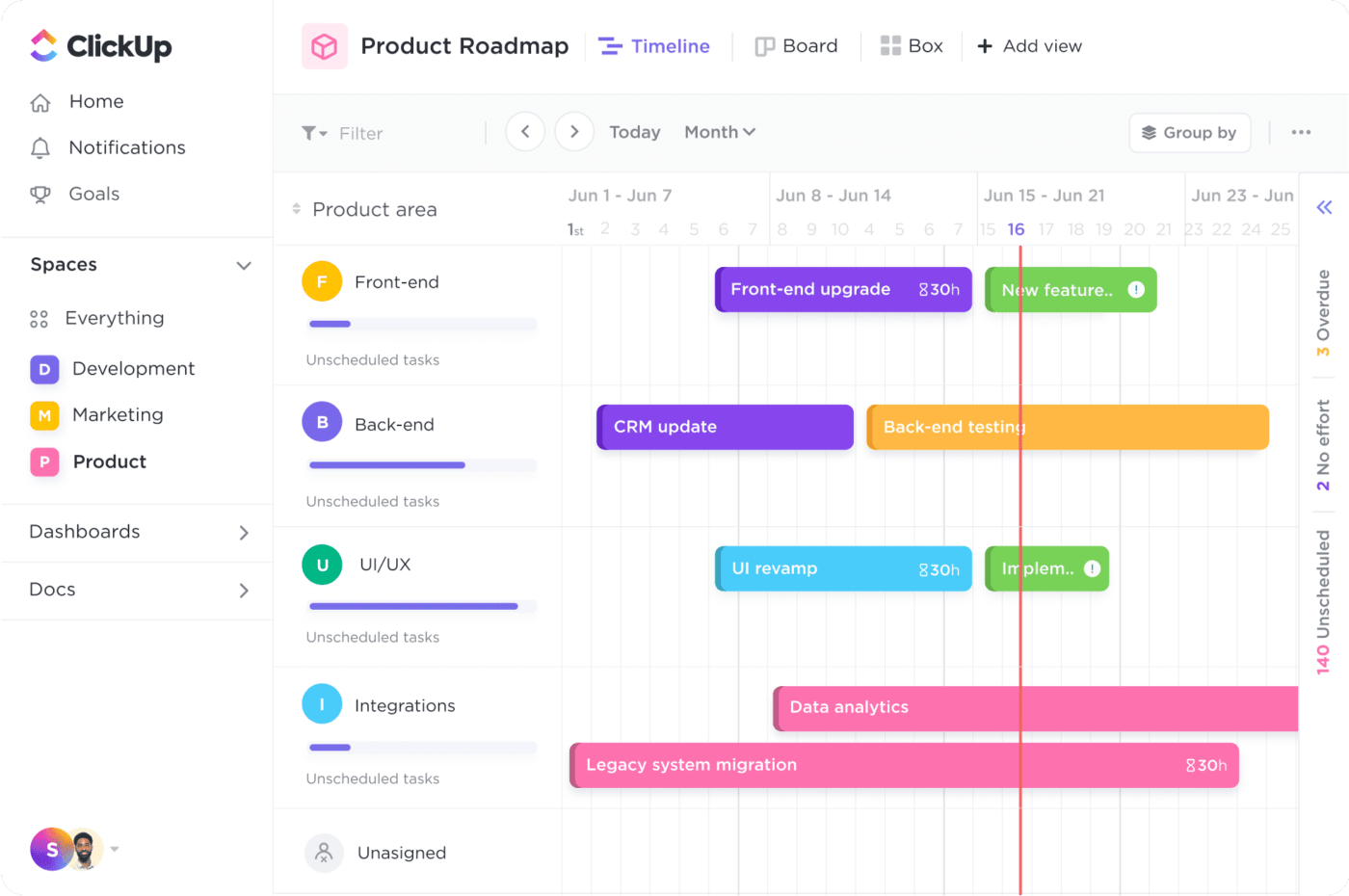
قم بجدولة مشاريع متعددة، وإدارة التبعيات، وتحديد أولويات كل شيء في الجدول الزمني للمشروع مع عرض الجدول الزمني في ClickUp
مع الأعمال تخطيط العملية والتحسين، يمكنك التقاط الأشياء قبل أن تتاح لها الفرصة لعرقلة الأداء أثناء التنقيح حتى تتمكن من القضاء على أوجه القصور، وتحسين رضا الموظفين والعملاء، وتبسيط عملية المؤسسة بأكملها بشكل عام نحو الأفضل.
## لماذا يعتبر تحسين عمليات الأعمال مهم؟
تتداخل الكثير من الأسباب التي تجعل تحسين عمليات الأعمال أمرًا ضروريًا مع أهداف معظم المؤسسات بالفعل، مثل
- كفاءة التكلفة: كيف يمكنك الحصول على أكبر قيمة من أدواتك ومواردك؟ فكر في هذا الأمر على أنه إنجاز المزيد بموارد أقل، كل ذلك دون المساس بالجودة، مثل التخلص من المهام المتكررة التي تستغرق وقتًا طويلاً باستخدام الأتمتة المناسبة وأدوات التحسين المستمر 🛠
- تحسين الجودة: إن إيجاد طريقة لتحسين جودة السلعة أو الخدمة يمكن أن يعني الارتقاء بالتجربة الكاملة التي يخوضها شخص ما في التعامل مع مؤسستك، سواء كان ذلك من خلال سلعة عالية الجودة أو من خلال تأهيل أحدث عميل
- رضا العملاء : يمكن أن يؤدي تحسين تجربة العملاء، سواء من خلال تسريع أوقات الشحن والتسليم، أو منتجات ذات جودة أعلى، أو خدمة عملاء أفضل، إلى زيادة الربحية
- رضا الموظفين: يمكن أن يؤدي تحسين العمليات الحالية وتنفيذ التغييرات إلى إحداث فرق كبير لأعضاء الفريق. يمكن أن يقلل من الإحباط، ويوفر توازنًا أفضل بين العمل والحياة، ويحسن التواصل، ويزيد الإنتاجية
- البقاء في المنافسة: يمكن أن تساعدك BPI على التكيف مع التغيرات في السوق. تمكّنك بيئة العمل الأكثر مرونة من رؤية وضع شركتك في الوقت الفعلي حتى تتمكن من الاستجابة عندما تتغير تفضيلات العملاء، وتصبح أكثر كفاءة، وتصبح أكثر كفاءة، وتتمكن من التمحور عندما تحتاج إلى ذلك
- قابلية التوسع: يمكن أن يساعد التحسين المستمر شركتك على النمو والتعامل مع التعقيدات المتزايدة دون المساس بالأداء أو الإيرادات. عندما تكون عملياتك الحالية مبسطة قدر الإمكان، يمكن لمؤسستك الحفاظ على الجودة والكفاءة بسلاسة في جميع المجالات، وتحسين الموارد، وتقليل الأخطاء، وجذب الاستثمار 🙌
- التخفيف من المخاطر: يمكن أن تساعدك إعادة هندسة العمليات على تحديد نقاط الضعف والعثور على السبب الجذري للاختناقات التي تؤثر على عملك، سواء كان ذلك في طرح منتجات جديدة أو تأهيل عملاء جدد. يمكنك أيضًا معرفة أين يمكن لأتمتة العمليات أن تقضي على الأخطاء البشرية، وتقلل من المشكلات القانونية والغرامات، وتساعدك على إعدادخطط الطوارئ لسيناريوهات "ماذا لو"
- زيادة الإنتاجية والكفاءة: يمكن أن تساعدك BPI على تطوير أكثر كفاءةاستراتيجيات إدارة المشاريع وتحديد مكان تنفيذ العمليات مثل أتمتة سير العمل، والتي يمكن أن تساعد أعضاء الفريق على إكمال عملهم بكفاءة أكبر. يمكن أن يساعد أيضًا في تخصيص الموارد بشكل أفضل، مما يوفر الوقت الذي يمكن استخدامه في أنشطة أكثر استراتيجية مثل العصف الذهني لمزيد من مبادرات التحسين والابتكار
تذكّر أن كل هذه الجوانب تندرج تحت بند الاستمرارية كفاءات العملية والتحسينات. يسهل اتخاذ القرارات المستندة إلى البيانات إجراء التعديلات حسب الحاجة في مؤسستك.
فوائد وتحديات تحسين عمليات الأعمال
مثل معظم الأشياء، هناك وجهان للعملة مع تحسين إجراءات العمل. في حين أن هناك بالتأكيد فوائد واضحة، إلا أن هناك أيضًا بعض التحديات التي تصاحب القيام بالأشياء بشكل مختلف.
فوائد تحسين عمليات الأعمال
استكشاف نهج جديد لـ إدارة العمليات يمكن أن تُحدث فرقًا كبيرًا في زيادة كفاءة الأعمال وإيجاد حلول فعالة من حيث الوقت والتكلفة لنقاط الضعف والاختناقات، كما ناقشنا سابقًا.
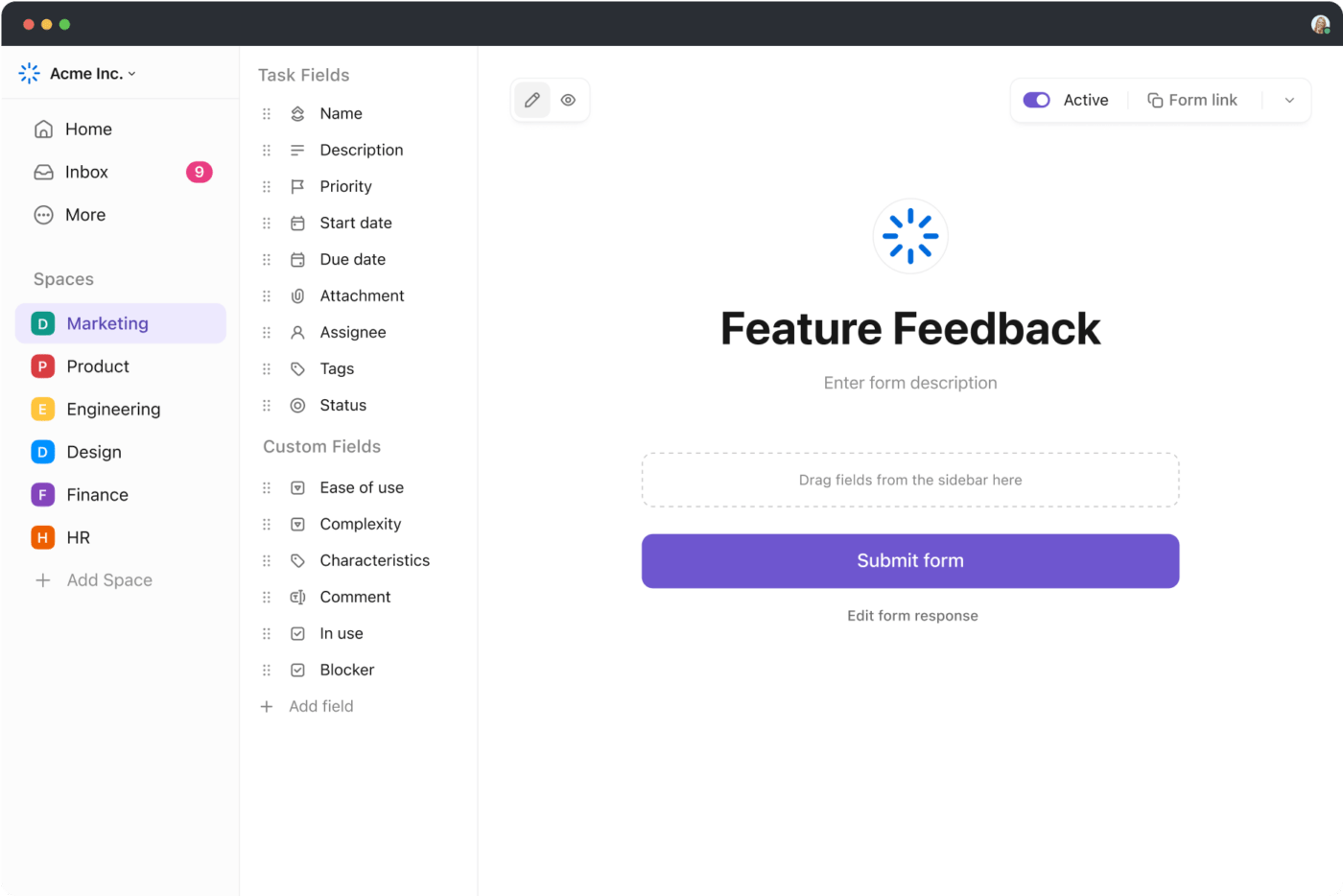
قم بإنشاء نماذج متعمقة داخل ClickUp 3.0 مع إمكانيات السحب والإفلات لإدراج الحقول وإضافة منطق شرطي لجمع ملاحظات أفضل
إن خلق مرونة تنظيمية يمكن أن تتكيف وتتغير في السوق عند الضرورة أمر لا يقدر بثمن، وكذلك خلق تجربة ممتازة للعملاء والموظفين. تمنحك البيانات والمقاييس الأفضلية وتسمح باتخاذ قرارات ثاقبة ومستنيرة يمكنها تعزيز الابتكار وقابلية التوسع.
كل هذه الفوائد هي نتائج محتملة لتحسين عمليات الأعمال. ✨
تحديات تحسين عمليات الأعمال التجارية
بقدر ما يمكن أن تكون النظرة المستقبلية وردية مع تحسين عمليات الأعمال، فإن بعض التحديات المحتملة ضرورية للنظر فيها:
- التكلفة الأولية: سواء استثمرت مؤسستك في برامج جديدة وأدوات تحسين إجراءات العمل أو توظيف استشاري، فقد تكون المراحل الأولى من تحسين إجراءات العمل مكلفة
- مقاومة التغيير: هناك دائمًا احتمال ألا يتقبل أعضاء الفريق وأصحاب المصلحة التغييرات التي قد تطرأ علىكفاءة العملية التغييرات، وبدون موافقتهم، فإن أي تغييرات يتم تنفيذها حديثًا يمكن أن تتعرقل
- التعقيد: قد تتطلب الأنظمة والعمليات المعقدة الاستعانة بمتخصص أو استشارات خارجية إذا كان فريقك بحاجة إلى اكتساب مجموعة المهارات اللازمة لتنفيذ التغييرات
- الحفاظ على العملية الجديدة التحسينات: بمجرد تنفيذ التغييرات في العملية، ضع في اعتبارك ما سيتطلبه الأمر لدعم هذه التغييرات والحفاظ عليها على المدى القصير والطويل
- التحديات التقنية: مع البرمجيات الجديدة تأتي تحديات جديدة، سواء كان ذلك منحنى تعليمي لمختلف أعضاء الفريق أو ثغرات محتملة في الأمن السيبراني والخصوصية
- تقلبات السوق: قد يكون النظام المطبق حديثاً مناسباً تماماً لمؤسستك اليوم، وقد يحتاج إلى التعديل والتغيير غداً. إن البقاء متيقظاً يمكن أن يساعدك على ركوب موجة التغييرات داخلياً داخل مؤسستك وخارجياً في سوق العمل
أكثر 7 تقنيات تحسين عمليات الأعمال فعالية أكثر تقنيات تحسين عمليات الأعمال فعالية
يمكنك الاختيار من بين العديد من منهجيات تحسين العمليات لتبسيط مؤسستك. فبدلاً من تكريس الوقت والموارد لإطفاء الحرائق، يمكنك منع حدوثها في المقام الأول من خلال تطبيق الأسلوب المناسب لعملك. 📚
لذا، إذا كنت مستعدًا للتحول من حل المشاكل بطريقة تفاعلية إلى التحسين الاستباقي، تحقق من هذه القائمة التي تضم أكثر سبع تقنيات فعالة يمكنك توظيفها في مؤسستك.
1. إدارة الجودة الشاملة
إدارة الجودة الشاملة، أو إدارة الجودة الشاملة، هي نهج شامل ومفصّل لتحسين عمليات الأعمال يركز على تحسين جودة السلع والخدمات. وهي تحقق ذلك من خلال التحسين المستمر استجابةً للتغذية الراجعة وغرس الإحساس بالجودة في كل جانب من جوانب المؤسسة.
ومن الجوانب الأساسية الأخرى لإدارة الجودة الشاملة المشاركة الكاملة للموظفين على كل مستوى من مستويات المؤسسة. فمن الموظف الأدنى رتبة إلى مستوى الإدارة والقيادة، يعمل الموظفون معًا لخلق تجربة ذات جودة عالية حيث يكون الهدف النهائي هو إرضاء العميل.
من خلال تحسين العمليات، يمكن تحديد أوجه القصور والاختناقات من خلال تحسين العمليات، بحيث يمكن للمؤسسة القضاء على الهدر وتحسين عملياتها.

عرض التقديرات الزمنية لمهام ClickUp وتتبعها بسهولة لإدارة الموارد بشكل أفضل
اطلع على كيفية استخدام انقر فوق لحجب الوقت . قم بتخطيط ومراقبة وإدارة سعة العمل لديك، ووضع أطر زمنية واضحة للمشاريع، والاطلاع على كل مهمة يعمل عليها أعضاء الفريق من خلال عرض لوحة المعلومات.
تستخدم إدارة الجودة الشاملة أيضًا أدوات مثل سداسية سيجما والإنتاج اللين (المزيد عن ذلك قريبًا).
2. كايزن
هي فلسفة أعمال يابانية للتحسين المستمر، وعلى عكس إدارة الجودة الشاملة، تركز كايزن بشكل أقل على الجودة وتركز أكثر على التغيير والتحسين المستمر من خلال القضاء على الهدر وتحسين العمليات.
فكّر في كايزن كنهج يأخذ بعين الاعتبار التغييرات الصغيرة التي يمكن إجراؤها الآن لإحداث أكبر تأثير لاحقًا. 👀
قد تكون كايزن أكثر شهرة لارتباطها بتويوتا، حيث خلقت ثقافة التأمل الذاتي العميق التي هي طريقة للوجود والعمل أكثر من كونها نهجًا محددًا.
3. سداسية سيجما
طورها المهندس بيل سميث في شركة موتورولا في ثمانينيات القرن العشرين، وتعد سيكس سيجما تقنية لتحسين العمليات التجارية تركز على تحسين الجودة عن طريق إزالة ما يسبب الأخطاء وتقليل التباين. ومن خلال مزيج من الأساليب الإدارية والإحصائية، فإن إطار عمل سداسية سيجما يساعد أعضاء الفريق في المؤسسة على أن يصبحوا خبراء في المنهجية.
وباستعارة مصطلحات من فنون الدفاع عن النفس، يُشار إلى هؤلاء الخبراء باسم "الأحزمة الخضراء" و"الأحزمة السوداء" و"الأحزمة السوداء الرئيسية"
### 4. الإحباط التصنيع
استراتيجية عملية تجارية أخرى مرتبطة بتويوتا، التصنيع الخالي من الهدر (يشار إليه أيضًا باسم التصنيع المرن) هو نهج يهدف إلى تحقيق الكفاءة القصوى مع تقليل الهدر إلى أدنى حد ممكن، كل ذلك دون التضحية بالإنتاجية.
والهدف النهائي هو إرضاء العميل.
من خلال تحديد القيمة، يمكن إجراء التعديلات المناسبة، مثل التخلص من أي خطوات مهدرة تعترض طريق هذه القيمة وخلق التدفق اللازم لتحقيق الكفاءة في تنفيذ ذلك.
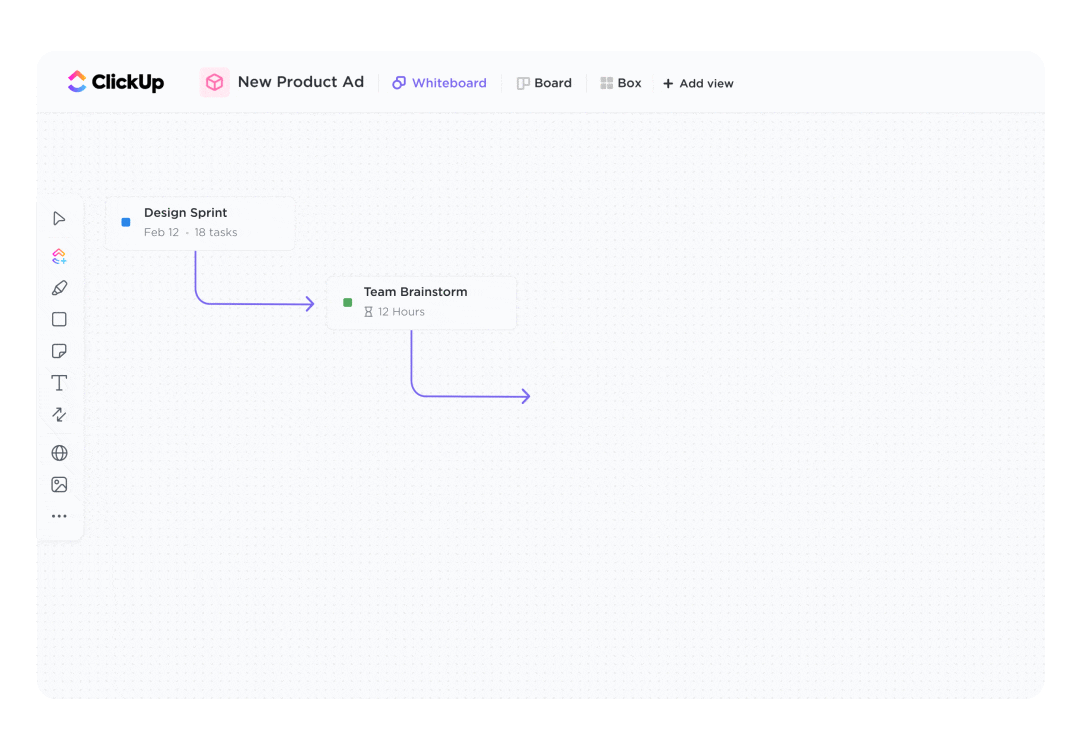
ارسم الروابط واربط العناصر معًا لإنشاء خرائط طريق أو سير عمل من أفكارك مع فريقك في ClickUp Whiteboards
استخدام الخرائط الذهنية ل ClickUp يمكن أن تساعدك ميزة الخرائط الذهنية في تخطيط وتنظيم أفكارك ومشاريعك ومهامك. يمكنك بسهولة رسم خريطة لسير العمل ورسم الروابط بين الأفكار التي تساعدك أنت ومؤسستك على أن تكون فعالة قدر الإمكان.
5. نظرية القيود
إن نهج نظرية القيود هو أسلوب لتحسين عمليات الأعمال يركز على إيجاد عنق الزجاجة أو القيد في المؤسسة وتعظيم كفاءة تلك المشكلة. لذا، سواء كانت هناك مشكلة في خط الإنتاج أو أداة برمجية غير فعالة، يمكن للمؤسسة أن تتكيف لتحقيق أقصى قدر من الكفاءة.
بمجرد أن تقوم المؤسسة بتحديد القيد وتصحيحه، فإن كل ما يعيق الكفاءة لم يعد عاملاً مقيدًا.
6. رشيقة
على غرار تقنيات تحسين إجراءات العمل الأخرى في قائمتنا, التعلم الرشيق وتؤكد المنهجية على إجراء تغييرات أصغر وأكثر تدرجية بدلاً من إصلاح النظام بالكامل.
يُعتبر كل تغيير بمثابة "سباق سريع"، حيث يتم تقييم تأثير التغيير في نهاية كل سباق سريع. ونظرًا لأنه يتم تقييم الأمور في كل خطوة على الطريق، فمن السهل على المؤسسة إجراء تعديلات وإعادة تنظيمها بشكل سريع.
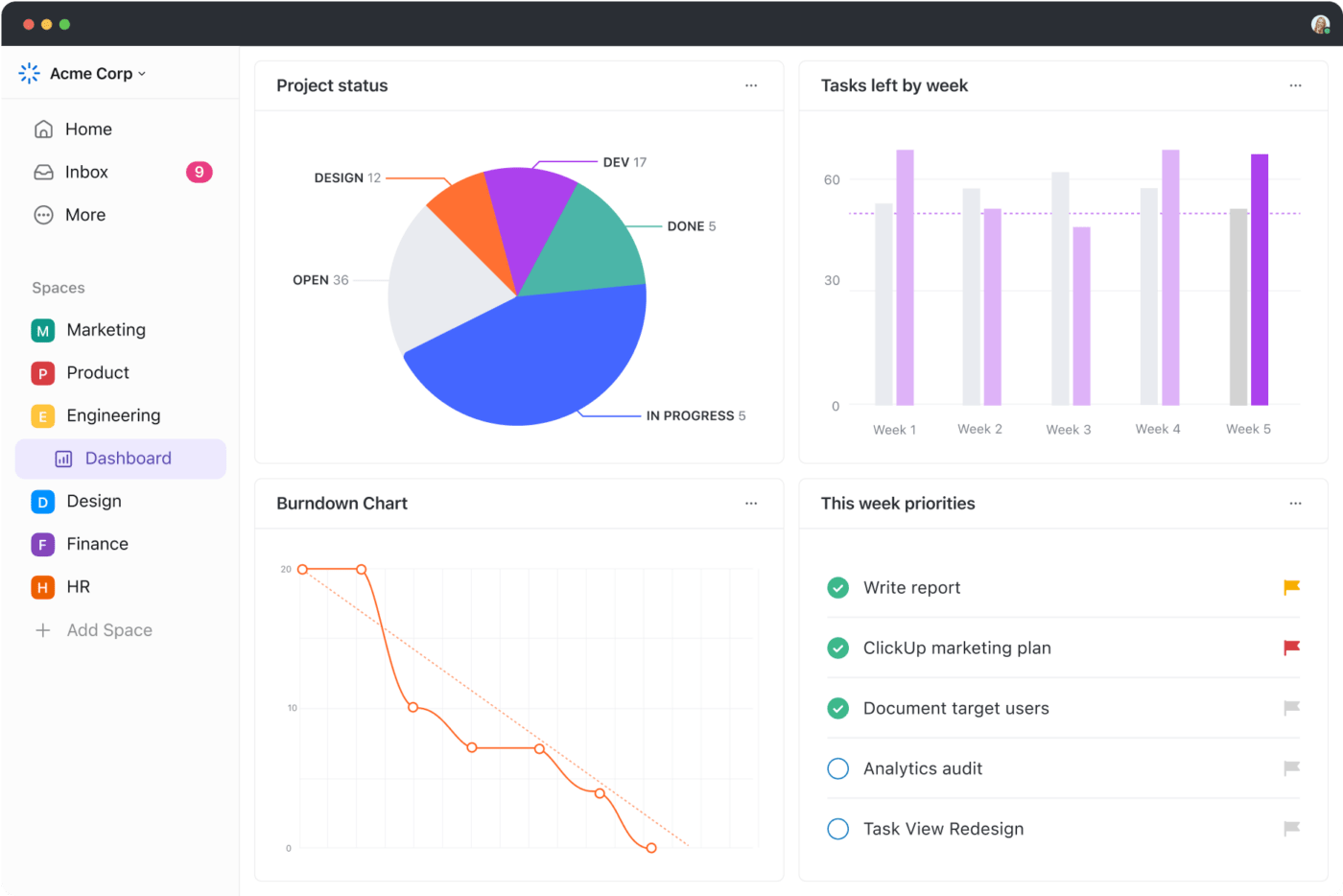
توفر لوحات المعلومات في ClickUp 3.0 لمديري المشاريع الرشيقة عرضًا سريعًا للمهام والأولويات المتبقية للفريق خلال الأسبوع، بالإضافة إلى مخططات تفصيلية لمراحل التنفيذ والتراجع
عنصر آخر من عناصر أجايل هو العمل مع أعضاء الفريق عبر المؤسسة والنظر في كيفية مساعدة وجهات النظر المختلفة في إيجاد الحل الأكثر فعالية لنقاط الألم التي تواجهها المؤسسة. إذا كنت تنجذب نحو النهج الرشيق، جرّب ما يلي ميزات الفرق الرشيقة في ClickUp .
يمكنك بسهولة إدارة خرائط طريق المنتجات، والأعمال المتراكمة، وسباقات السرعة، وتصميم تجربة المستخدم، وغير ذلك الكثير باستخدام هذه المنصة المتكاملة.
7. كانبان
كانبان، وهو نهج آخر نشأ في اليابان، هو طريقة فعالة لتحسين عمليات الأعمال من خلال تسهيل تصور سير العمل وتحسين العمليات بشكل تدريجي ومعرفة أماكن الاختناقات في المؤسسة.
وعلى غرار المخطط الانسيابي، تسهّل منهجية كانبان رؤية مكان وجود المؤسسة في الوقت الفعلي وكيفية تحركها خلال عملية التحسين. من خلال الحد من عدد المهام المرتبطة بتحسين عملية عمل معينة، يركز أعضاء الفريق على إكمال المهام المرتبطة بهذا الهدف قبل الانتقال إلى مهام جديدة، مما يخلق المزيد من الكفاءة في المؤسسة. 🌻
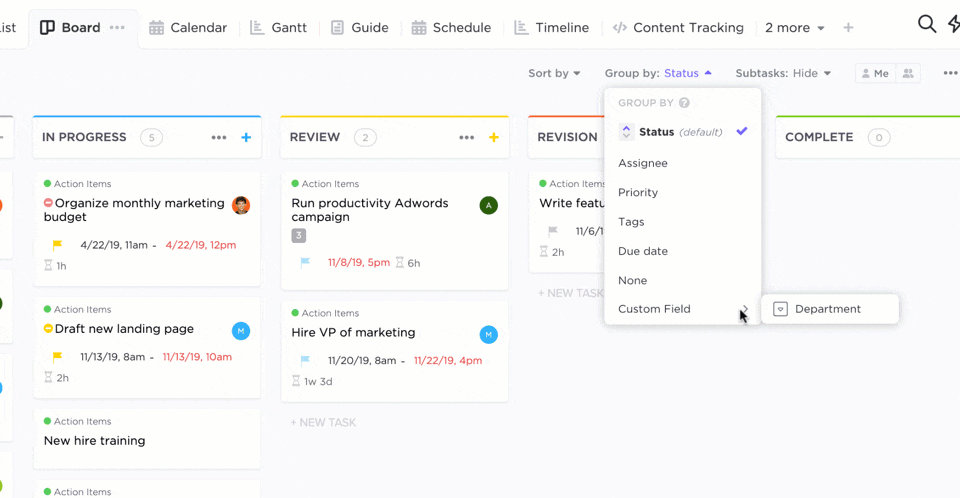
قم بتجميع المهام على لوحة كانبان حسب الحالة والحقول المخصصة والأولوية والمزيد في طريقة عرض لوحة ClickUp
ولأن كانبان يعمل على نظام السحب، لا يتم إنشاء مهام جديدة مرتبطة بالتحسين إلا عندما تكون هناك حاجة لذلك، مما يجعله نهجًا لمبادرة BPI يتماشى مع متطلبات المؤسسة.
جرّب تخطيط كانبان مع عرض لوحة ClickUp ، بالإضافة إلى أكثر من 15 طريقة عرض أخرى، لمساعدتك على تخصيص كل شيء ليناسب احتياجات مؤسستك وتصور سير عملك وتحسين العملية على طريقتك.
## 5 نماذج لمساعدتك في تحسين سير العمل
هناك الكثير من برامج توثيق العمليات خيارات للمساعدة في تحسين إجراءات العمل في مؤسستك. إحدى الأدوات متعددة الاستخدامات بشكل استثنائي لكل شيء بدءًا من تحليل SWOT إلى إدارة المشاريع وتتبع العادات وتحسين إجراءات العمل هي ClickUp .
أنشئ جداول زمنية واضحة وأهدافًا قابلة للقياس وتتبع التقدم المحرز تلقائيًا باستخدام ميزة أهداف ClickUp . أكثر من ذلك, أتمتة ClickUp تجعل أتمتة المهام المتكررة أمرًا سهلاً.
وبفضل القوالب المصممة بشكل مثالي لتحسين عمليات الأعمال، يمكنك تطوير استراتيجيتك وتنفيذها كلها باستخدام أداة واحدة. فيما يلي خمسة قوالب يمكنك أنت ومؤسستك استخدامها لهيكلة تحسينات عمليات الأعمال في مؤسستك.
1. قالب مراجعة أداء ClickUp للأداء
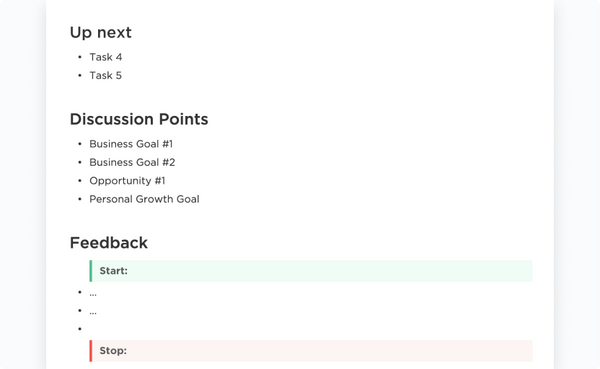
يساعد نموذج ClickUp لمراجعة أداء الموظفين في ClickUp فرق العمل على مشاركة الملاحظات والتحسينات القابلة للتنفيذ بشكل أفضل
تُعد مراجعات الأداء جانباً أساسياً لدعم أعضاء الفريق من خلال مساعدتهم على تلقي ملاحظات قيّمة، سواءً بتقديم وجهة نظر حول مجالات التحسين أو تقدير الموظفين الذين يتجاوزون التوقعات.
ومع ذلك، قد تبدو مراجعات الأداء مرهقة في تنظيمها وتجميعها. مع قالب مراجعة الأداء الخاص ب ClickUp ، يمكنك بسهولة تتبع أداء الموظفين مع مرور الوقت والتأكد من أن أعضاء الفريق يلبون الأهداف والغايات مع الحقول والحالات المخصصة التي تتكيف مع مؤسستك.
2. قالب تدقيق وتحسين عملية ClickUp
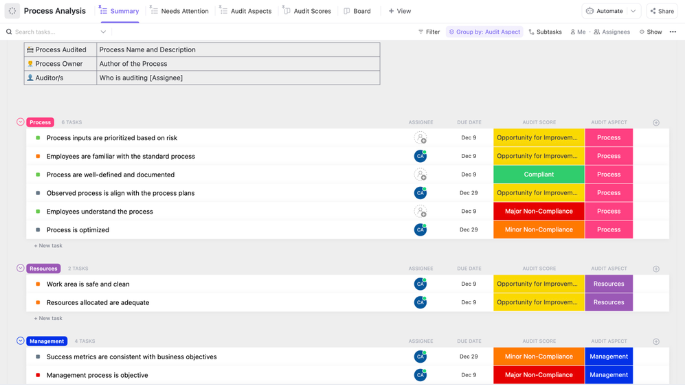
استخدم قالب ClickUp لتدقيق العمليات وتحسينها للحصول على نظرة فورية على حالة عملياتك، ومعرفة ما الذي يعمل، وما الذي يحتاج إلى تحسين
تقييم فعالية عملياتك الحالية باستخدام نموذج تدقيق العمليات وتحسينها من ClickUp يساعدك على معرفة ما تعمل به مؤسستك. ومن هناك، يمكنك تحديد ما هي العمليات التجارية التي يمكن تحسينها والحصول على خطوات تالية واضحة لتنفيذ التغييرات المناسبة في الوقت المناسب.
من خلال التحقق بانتظام من حالة عمليات أعمالك التجارية، يمكنك بسهولة اكتشاف مجالات إعادة التنظيم في وقت مبكر وفي كثير من الأحيان والحفاظ على جودة تلك العمليات المنفذة حديثًا بمرور الوقت.
3. قالب عملية ClickUp FMEA عملية Lean Six Sigma Lean Six Sigma

اكتشف المخاطر المحتملة بسرعة و وضع خطة للعمل باستخدام نموذج ClickUp Process FMEA Lean Six Sigma Lean Six Sigma
من الخيارات الأخرى لتحديد الثغرات في العمليات بسرعة واكتساب الوضوح اللازم لمعالجتها بأكبر قدر من الكفاءة قالب ClickUp's Process FMEA Lean Six Sigma Lean Six Sigma . هذا القالب الشامل يجعل من السهل توضيح مجالات التحسين المستمر عبر عمليات الأعمال مع إنشاء خطة عمل مع مواءمة الفريق لإجراء التغييرات اللازمة.
من خلال تحسين العمليات الجديدة والحالية من أجل السلامة والكفاءة، يمكن للمؤسسة تقليل استياء العملاء وتحسين جودة المنتجات بسهولة.
4. قالب ClickUp DMAIC
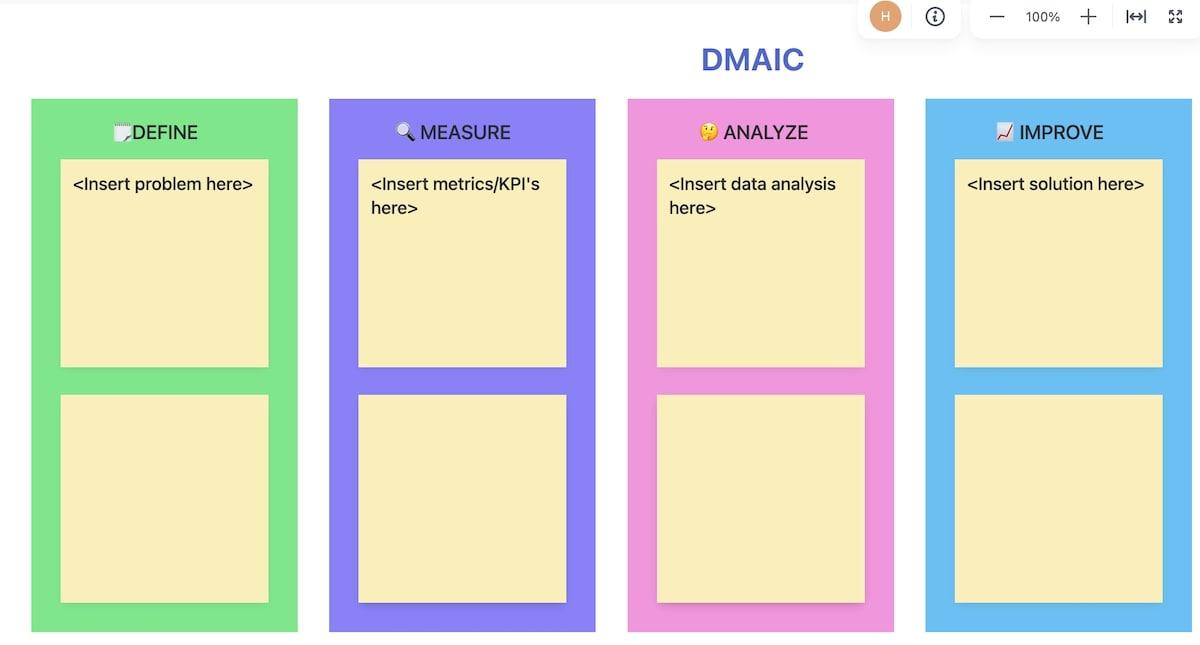
تصبح العمليات غير المنظمة فعالة في لمح البصر باستخدام قالب ClickUp DMAIC
يرمز DMAIC إلى تحديد وقياس وتحليل وتحسين والتحكم ويساعد في تحسين العمليات. قالب DMAIC الخاص ب ClickUp يحدد نطاق المشروع بأهداف محددة بوضوح وسهلة الفهم. قم بقياس مؤشرات الأداء الرئيسية مقابل الأهداف، وحدد الأسباب الجذرية، وقم بتحسين عمليات إدارة عمليات الأعمال الخاصة بك بشكل مباشر. يمكنك حتى تتبع النتائج المستمرة أيضًا.
الكفاءة هي اسم اللعبة مع عمليات تحسين الأعمال وهذا القالب يساعدك على القيام بذلك. حدد بسرعة أهداف أعمال مؤسستك وحدد أولوياتها ووضع نهج منظم لزيادة الكفاءة، واكتسب رؤى لاتخاذ قرارات مستنيرة وقائمة على البيانات، واعرض النتائج القابلة للقياس بمرور الوقت.
5. انقر فوق قالب كانبان
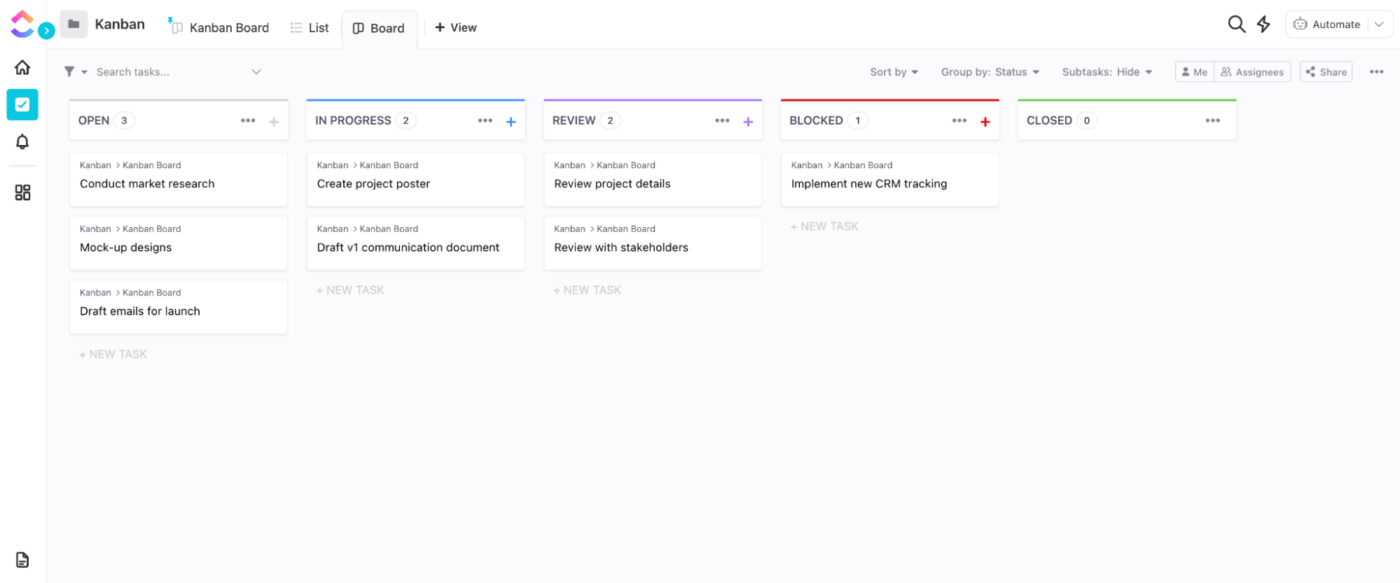
يغطي قالب لوحة كانبان البسيط من ClickUp جميع الأساسيات لبدء استخدام لوحات كانبان في أسرع وقت ممكن
يحقق قالب كانبان الصحيح التوازن المثالي بين الهيكلية والمرونة. مع قالب كانبان الخاص ب ClickUp يمكنك القيام بذلك بالضبط.
قم بتقسيم المشاريع بسهولة إلى أجزاء يمكن إدارتها وإعداد فريقك للنجاح، كل ذلك مع إنشاء قنوات اتصال واضحة حتى يكون الجميع على نفس الصفحة في نفس الوقت. مع تحسين التواصل وزيادة وضوح الرؤية في قدرة الفريق والتقدم، واستخدام أكثر كفاءة للموارد، لديك وصفة للنجاح في تنفيذ عمليات تحسين الأعمال الجديدة.
تحسين أدواتك من أجل التحسين المستمر للعمليات
يمكن أن يكون تحسين العمليات التجارية أمرًا ضروريًا لمساعدة مؤسستك على إيجاد طريقها نحو النمو المستدام مع الحفاظ على قدرتها التنافسية في السوق.
تؤثر القدرة على التحسين المستمر للعمليات والتكيف مع التغيرات في مشهد الأعمال بشكل مباشر على كفاءة التكلفة. يتيح تحسين العمليات التجارية للمؤسسة تقديم قيمة أفضل للعملاء، كل ذلك مع الحفاظ على الانسيابية والكفاءة قدر الإمكان. 🙌
هل أنت مستعد للبدء في تحسين إجراءات العمل؟ لدى ClickUp كل ما تحتاجه. تعمل منصتنا المتكاملة على تبسيط عملك من خلال منح فريقك مساحة لتبادل الأفكار وتتبع الأهداف وتنظيم المهام وإنشاء المستندات والتواصل مع بعضهم البعض في الوقت الفعلي.
وبفضل أكثر من 1000 عملية تكامل، يمكنك جعل جميع الأدوات الأخرى التي تحافظ على سير عمل فريقك مركزية. يمكن أن يبدأ سير العمل الأفضل والأسهل اليوم عندما اشترك في ClickUp-إنه مجاني للأبد .

